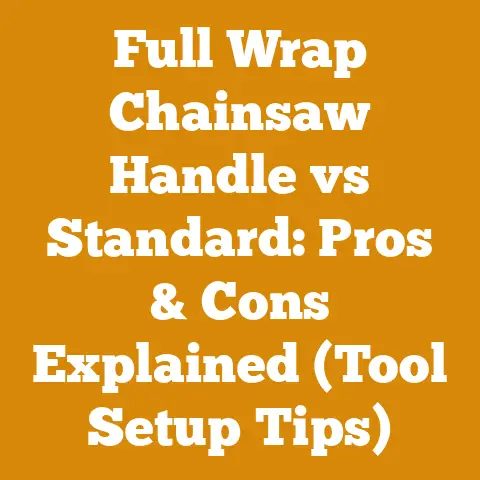Can You Use Teflon Tape on Hydraulic Fittings? (5 Pro Tips)
Imagine trying to seal a leaky garden hose with duct tape – frustrating, right? You think you’ve got it fixed, only to see water spraying everywhere again. That’s kind of like using Teflon tape (also called PTFE tape or plumber’s tape) on hydraulic fittings. It might seem like a quick fix, but in the long run, it can cause more headaches than it solves. I’ve seen firsthand the damage improper sealing can do in hydraulic systems, from minor leaks to catastrophic failures that can bring a whole logging operation to a standstill. This article is all about understanding why Teflon tape isn’t usually the right choice for hydraulic fittings and what you should be using instead, along with some pro tips I’ve gathered over years of working with wood processing and logging equipment.
Can You Use Teflon Tape on Hydraulic Fittings? (5 Pro Tips)
The short answer is: generally, no. While Teflon tape is fantastic for plumbing applications, hydraulic systems operate at much higher pressures and require a different approach to sealing. Let’s dive into why, and then I’ll share some pro tips to keep your hydraulic systems leak-free and running smoothly.
Why Teflon Tape Isn’t Ideal for Hydraulic Fittings
Hydraulic systems are the workhorses of the wood processing and logging industries. They power everything from chainsaws and log splitters to massive forestry equipment. Understanding why Teflon tape doesn’t cut it in these high-pressure environments is crucial.
- Pressure Ratings: Teflon tape is designed for relatively low-pressure systems, like water pipes. Hydraulic systems, on the other hand, can operate at pressures of several thousand PSI (pounds per square inch). The tape simply isn’t strong enough to withstand these pressures consistently.
- Contamination Risk: As the hydraulic fluid flows through the system, it can degrade the Teflon tape. Tiny pieces of the tape can then break off and contaminate the fluid. These particles can clog valves, damage pumps, and cause all sorts of problems down the line. I’ve spent hours flushing hydraulic systems just to remove contaminants introduced by improper sealing.
- Fitting Design: Hydraulic fittings are typically designed to create a metal-to-metal seal, often using O-rings, flared fittings, or specialized sealing compounds. Teflon tape can actually interfere with this intended seal, making leaks more likely.
- Incompatibility with Certain Fluids: Some hydraulic fluids are incompatible with Teflon tape, causing it to degrade or swell. This can lead to leaks and contamination. Always check the compatibility of any sealing material with the specific hydraulic fluid you are using.
Pro Tip #1: Understanding Hydraulic Fitting Types
Before we talk about alternative sealing methods, it’s essential to understand the different types of hydraulic fittings. Using the wrong sealant with the wrong fitting is a recipe for disaster. I once spent a freezing January afternoon trying to diagnose a leak on a log splitter, only to realize someone had used Teflon tape on a JIC fitting that was supposed to seal metal-to-metal. Talk about a facepalm moment!
- JIC (Joint Industry Council) Fittings: These fittings use a 37-degree flared connection to create a metal-to-metal seal. No sealant is typically required or recommended. Overtightening JIC fittings is a common mistake that can damage the flare and cause leaks.
- ORFS (O-Ring Face Seal) Fittings: As the name suggests, these fittings use an O-ring to create a seal between the fitting face and the mating surface. The O-ring provides a reliable, leak-free seal even under high pressure.
- NPT (National Pipe Thread) Fittings: These fittings use tapered threads to create a seal. Unlike JIC and ORFS fittings, NPT fittings do require a sealant. However, Teflon tape is often not the best choice, as we’ll discuss later.
- SAE (Society of Automotive Engineers) Fittings: This is a broad category that includes various types of hydraulic fittings, including flared, O-ring, and threaded connections.
Pro Tip #2: Choosing the Right Sealing Method
So, if Teflon tape is generally a no-go, what should you use to seal hydraulic fittings? The answer depends on the type of fitting and the specific application.
- For JIC and ORFS Fittings: As mentioned earlier, these fittings are designed to seal metal-to-metal or with an O-ring. No sealant is typically required. Ensure the mating surfaces are clean and free of debris. Inspect O-rings for damage and replace them if necessary. A light coat of hydraulic fluid on the O-ring can help with installation.
-
For NPT Fittings: While Teflon tape is sometimes used on NPT fittings, I generally recommend using a liquid thread sealant specifically designed for hydraulic applications. These sealants are formulated to withstand high pressures and resist degradation from hydraulic fluids.
- Anaerobic Sealants: These sealants cure in the absence of air and are ideal for creating a reliable, long-lasting seal on NPT fittings. Loctite 545 is a popular choice for hydraulic applications.
- Pipe Dope: Pipe dope, also known as pipe joint compound, is another option for sealing NPT fittings. Choose a pipe dope that is specifically formulated for use with hydraulic fluids.
Important Note: When using any thread sealant, apply it sparingly to the male threads only. Avoid getting sealant on the first few threads to prevent contamination of the hydraulic system.
Pro Tip #3: Proper Installation Techniques
Even the best sealant won’t work if the fitting isn’t installed correctly. Here are some key installation techniques to keep in mind:
- Cleanliness is Key: Before installing any hydraulic fitting, make sure the threads and mating surfaces are clean and free of debris. Use a clean rag or brush to remove any dirt, grease, or old sealant.
- Tightening Torque: Overtightening hydraulic fittings is a common mistake that can damage the threads, deform the sealing surfaces, and cause leaks. Use a torque wrench to tighten the fitting to the manufacturer’s recommended torque specification. Torque specifications vary depending on the fitting size and type, so consult the manufacturer’s documentation. I keep a torque chart handy in my workshop for quick reference.
- Backing Up Fittings: When tightening a hydraulic fitting, use a backup wrench to hold the mating fitting in place. This prevents the mating fitting from twisting and potentially damaging the hydraulic lines or components.
- Visual Inspection: After installing the fitting, visually inspect it for any signs of leaks. If you see any fluid seeping from the fitting, tighten it slightly. If the leak persists, loosen the fitting, inspect the threads and sealing surfaces, and reapply sealant if necessary.
Pro Tip #4: Troubleshooting Hydraulic Leaks
Despite your best efforts, hydraulic leaks can still occur. Here are some common causes of hydraulic leaks and how to troubleshoot them:
- Loose Fittings: This is the most common cause of hydraulic leaks. Check all fittings for tightness and tighten them as needed, using a torque wrench to ensure proper torque.
- Damaged O-Rings: Inspect O-rings for cracks, cuts, or other damage. Replace any damaged O-rings with new ones of the correct size and material.
- Worn Threads: Over time, the threads on hydraulic fittings can become worn or damaged. This can prevent the fitting from sealing properly. Replace any fittings with worn threads.
- Contaminated Fluid: Contaminated hydraulic fluid can damage seals and cause leaks. Regularly check the hydraulic fluid for contamination and replace it as needed. Follow the manufacturer’s recommended maintenance schedule for fluid changes.
- High Pressure: Exceeding the pressure rating of the hydraulic system can cause leaks and damage to components. Ensure the system is operating within its specified pressure range.
Finding the Source of the Leak: Sometimes, it can be tricky to pinpoint the exact source of a hydraulic leak. One trick I use is to clean the area around the suspected leak thoroughly and then dust it with talcum powder. The powder will highlight the leak path, making it easier to identify.
Pro Tip #5: Cost Considerations and Budgeting
Now, let’s talk about the financial side of things. Maintaining hydraulic systems can be expensive, but with proper planning and budgeting, you can minimize costs and avoid costly downtime.
- Preventative Maintenance: The best way to save money on hydraulic repairs is to prevent them from happening in the first place. Implement a regular preventative maintenance program that includes:
- Regularly inspecting hydraulic lines, fittings, and components for leaks, damage, and wear.
- Checking the hydraulic fluid level and condition.
- Replacing hydraulic filters according to the manufacturer’s recommendations.
- Lubricating moving parts as needed.
- Quality Parts: While it may be tempting to save money by using cheaper aftermarket parts, I’ve learned the hard way that it’s often a false economy. Cheap parts are more likely to fail, leading to more frequent repairs and downtime. Invest in quality parts from reputable manufacturers.
- Track Your Costs: Keep track of all your hydraulic maintenance and repair costs. This will help you identify trends, spot potential problems early, and budget more effectively for future repairs. I use a simple spreadsheet to track my costs, including the date, description of the repair, parts used, labor costs, and total cost.
- Negotiate Prices: Don’t be afraid to negotiate prices with your hydraulic parts supplier. They may be willing to offer discounts for bulk purchases or long-term contracts.
- Consider DIY vs. Professional Repair: Depending on your skills and experience, you may be able to handle some hydraulic repairs yourself. However, complex repairs should be left to qualified professionals. Factor in the cost of labor, parts, and potential downtime when deciding whether to DIY or hire a professional.
Cost Data and Benchmarks:
To give you a better idea of the costs involved in hydraulic maintenance and repair, here are some industry benchmarks and statistical data:
- Hydraulic Fluid Costs: The cost of hydraulic fluid varies depending on the type, brand, and quantity purchased. Expect to pay anywhere from \$5 to \$20 per gallon for standard hydraulic fluid. High-performance or synthetic fluids can cost significantly more.
- Hydraulic Filter Costs: Hydraulic filter costs also vary depending on the type and size. Expect to pay anywhere from \$10 to \$50 per filter.
- O-Ring Costs: O-rings are relatively inexpensive, typically costing a few cents to a few dollars each. However, the cost can add up if you need to replace a large number of O-rings.
- Labor Costs: The cost of labor for hydraulic repairs can vary depending on the location, the complexity of the repair, and the hourly rate of the mechanic. Expect to pay anywhere from \$75 to \$150 per hour for a qualified hydraulic mechanic.
- Downtime Costs: Downtime costs can be significant, especially for businesses that rely on hydraulic equipment for their operations. Consider the cost of lost production, delayed deliveries, and potential fines or penalties.
Example Cost Breakdown: Hydraulic Cylinder Repair
Let’s say you have a hydraulic cylinder on a log splitter that is leaking. Here’s a breakdown of the potential costs involved in repairing it:
- Parts:
- Seal kit: \$25 – \$75
- Hydraulic fluid (1 gallon): \$10 – \$20
- Labor (DIY):
- Your time: Let’s say 4 hours at a value of \$30/hour = \$120 (opportunity cost)
- Labor (Professional):
- 4 hours at \$100/hour = \$400
- Total Cost (DIY): \$155 – \$215
- Total Cost (Professional): \$435 – \$495
This is just an example, and the actual costs may vary depending on the specific situation. However, it gives you an idea of the factors to consider when budgeting for hydraulic repairs.
Additional Cost-Saving Tips:
- Buy in Bulk: If you use a lot of hydraulic fluid, filters, or O-rings, consider buying them in bulk to save money.
- Shop Around: Get quotes from multiple suppliers before purchasing parts or hiring a mechanic.
- Take Advantage of Warranties: Many hydraulic parts come with warranties. Be sure to register your parts and keep your receipts in case you need to make a warranty claim.
- Recycle Hydraulic Fluid: Some companies offer hydraulic fluid recycling services. This can save you money on disposal costs and help protect the environment.
- Consider Used Equipment: If you’re on a tight budget, consider purchasing used hydraulic equipment instead of new. Just be sure to inspect the equipment carefully and have it checked out by a qualified mechanic before you buy it.
The Bottom Line:
Hydraulic systems are vital for many industries, including wood processing and logging. Understanding how to properly maintain and repair these systems is essential for minimizing costs and maximizing productivity. While Teflon tape may seem like a quick and easy fix for hydraulic leaks, it’s generally not the best choice. Instead, use the appropriate sealing method for the type of fitting, follow proper installation techniques, and implement a regular preventative maintenance program. By doing so, you can keep your hydraulic systems running smoothly and avoid costly downtime. Remember, a little preventative maintenance goes a long way. It’s like sharpening your chainsaw – a few minutes of work can save you hours of frustration and keep your operation running efficiently.






